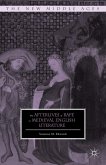This book investigates adaptations of The Lady of Shalott and Elaine of Astolat in Victorian and post-Victorian popular culture to explore their engagement with medievalism, social constructions of gender, and representations of the role of art in society. Although the figure of Elaine first appeared in medieval texts, including Malory's Le Morte Darthur, Tennyson's poems about the Lady and Elaine drew unprecedented response from musicians, artists, and other authors, whose adaptations in some cases inspired further adaptations. With chapters on music, art, and literature (including parody, young people's literature, and historical fiction and fantasy), this book seeks to trace the evolution of these characters and the ways in which they reinforce or challenge conventional gender roles, represent the present's relationship to the past, and highlight the power of art.
"Howey has created a very original, far-reaching, closely examined, and intricately argued book. I was very impressed by many aspects of her study, such as the detailed tables listing pre-1920 sheet music of songs based on Tennyson's Arthurian poems. Also impressive is her own musical expertise in the explanation of the very modern performance techniques of female soloists. ... I greatly enjoyed ... ." (Roger Simpson, Arthuriana, Vol. 31 (2), 2021)








